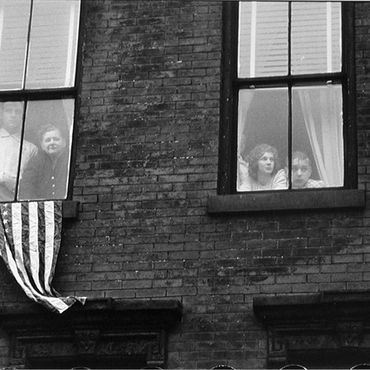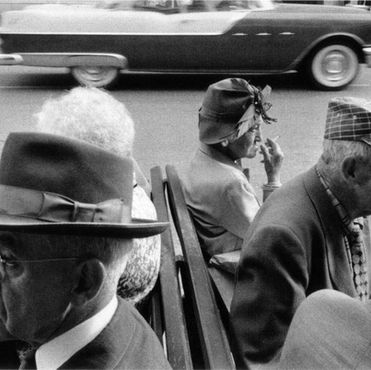FOTOTECA SIRACUSANA
PHOTOGALLERY - FOTOGRAFIA VINTAGE - BIBLIOTECA TEMATICA - CAMERA OSCURA B&W - DIDATTICA
ROBERT FRANK
Una finestra si spalanca nella cultura americana. Sono gli anni Cinquanta e niente più sarà destinato a rimanere uguale a prima. Il merito è di una controcultura che si fa scuola, che accartoccia la prosa tradizionale per trasformarla in poesia piana. Sono gli anni di “Jukebox all’idrogeno” di Ginsberg, della poesia strabiliata di Corso, Ferlinghetti e Orlovsky. Sono gli anni della “strada” su cui Kerouac muove i suoi demoni: sono gli anni della “beat generation”. E sulla strada si dipana il nuovo racconto della società americana: immagini di un quotidiano spoglio, quasi nudo, su cui posa lo sguardo in qualunque passaggio della giornata e teso alla descrizione della normalità dalla quale è attraversata.
Il vento nuovo investe ogni campo, dalla letteratura alla poesia, dall’arte al cinema. Nemmeno la fotografia ne è esente. Robert Frank (9 novembre 1924-9 settembre 2019) carica la sua attrezzatura fotografica su un’auto di seconda mano e con i dollari di una borsa di studio della Fondazione Guggenheim attraversa l’America. Scatterà qualcosa come 25 000 fotografie e ne trae un ritratto fedelissimo dell’America che lui, che ne è testimone, riporta senza commenti, senza apparente interpretazione. Nelle sue fotografie non c’è morale né giudizio: c’è invece un’America che parla di se stessa, quella non didascalica e alla periferia dell’epica del “sogno americano”. Nel suo viaggio nelle viscere inascoltate degli Stati Uniti Robert Frank incontra un Paese alla “mercé di una rude corrente” capace di trasportare con sé il destino di uomini e cose nel vorticoso accadere del Nulla all’incontro con la Storia. La fotografia della famiglia sulla spiaggia la cui giornata è incisa dalla morte di Marilyn Monroe, mentre garrisce la bandiera a stelle e strisce, è l’emblema del succedere, del frapporsi, della catastrofe minima per molti, grande per alcuni ma sempre catastrofe. O ispirazione, come la foto del cowboy urbano, perché John Schlesinger disse di essersi ispirato proprio a quella immagine per costruire il personaggio di Joe Buck in “Un uomo da marciapiede”. In altre, la curiosità di conoscere il destino di volti che abbiamo amato è irresistibile e senza risposta, come gli sguardi disincantati della ascensorista o della cameriera in un bar dove si mangia veloce come la vita. Umanità dunque colta nel momento più nudo, sincero, quello del tirare avanti. E senza gloria. Quando esce, “The Americans” non ha successo. E’ fuorviante, si dice, l’America da raccontare è un’altra e Frank è raggiunto da un’accusa di anti-americanismo da caccia alle streghe. La verità è pericolosa, almeno lì. In Europa è diverso. Infatti il libro è di nuovo editato, è il 1959, e questa volta con la prefazione di un amico celebre: Jack Kerouac. Tornato negli Stati Uniti il volume diventa un caso di successo; anzi, diventa il libro per immagini che traccerà un solco profondissimo nel linguaggio fotografico dei decenni a venire fino a cambiarlo alla radice.
A partire degli anni ’70 Frank quasi non fotograferà più. A interessarlo è altro. La staticità delle immagini è superata dalla dinamicità del documentario cinematografico. E lo fa in un modo che non lascia indifferenti. Non lasciò indifferente i “ragazzacci” dei Rolling Stones. Con la band inglese Frank girò un documentario, “Cocksucker Blues” che lasciò sgomenta l’intera band, trasgressiva sì ma molto attenta al marketing (si dice che Mick Jagger, davanti alla rabbia di Frank a seguito della censura, replicò al fotografo: “Il tuo documentario è magnifico, Robert, ma se esce una sola volta nelle sale a noi non sarà mai più permesso di mettere piede negli Stati Uniti”). Ma non c’è dubbio, benché nel mondo della fotografia c’è un “prima e dopo Frank”, che “The Americans” resti il suo capolavoro, un libro che ha obbligato tutti a fare i conti con il reportage documentario, perché “The Americans” narra l’America meglio di un trattato di sociologia e mostra il suo risultato nella discrezione dell’obiettivo, senza urla (è toccato a Ginsberg lanciare il suo “howl”, e ancora lo ascoltiamo) e denunce. “The Americans” è un manifesto, e Robert Frank è la sua voce.
Giuseppe Cicozzetti
da “The Americans”
foto Robert Frank
A window opens up in American culture. It’s the fifties and nothing will be destined to remain the same. The merit is of a counterculture that becomes a school, which shrugs the traditional prose to transform it into flat poetry.
These are the years of "Hydrogen Jukebox" by Ginsberg, of the amazed poetry of Corso, Ferlinghetti and Orlovsky. These are the years of the "road" on which Kerouac moves his demons: these are the years of the "beat generation". And on the road unfolds the new story of American society: images of everyday life, bare, on which the gaze is set in any passage of the day and aimed at describing the normality of which it is crossed.
The new wind invests every field, from literature to poetry, from art to cinema. Not even photography is exempt. Robert Frank (november 9,1924-september 9, 2019) loads his photographic equipment on a second-hand car and with the dollars from a Guggenheim Foundation scholarship crosses America.
He will shoot something like 25 000 photographs and draws a very faithful portrait of America that he, as witness, reports without comment, without apparent interpretation. In his photographs there is neither morality nor judgment: there is instead an America that speaks of itself, the non-didactic and the periphery of the epic of the "American dream".
On his voyage into the the United States’ unheard bowels, Robert Frank meets a country at the "mercy of a rude stream" capable of carrying with him the destiny of men and things in the whirlwind of Nothingness when meets History.
The photograph of the family on the beach whose day is engraved by the death of Marilyn Monroe, while garrishing the stars and stripes flag, is the emblem of success, ‘bout interpose, of the minimal catastrophe for many, great for some but always catastrophe.
Or inspiration, like the photo of the urban cowboy, because John Schlesinger said he was inspired by that image to build the character of Joe Buck in "Midnight Cowboy". In others, the curiosity of knowing the destiny of faces we have loved is irresistible and unanswered, like the disenchanted looks of the lifter or waitress in a bar where you eat as fast as life.
Humanity thus caught in the most naked, sincere moment, that of the "keep on keepin' on”. And without glory. When it comes out, "The Americans" is not successful. It is misleading, they say, America to tell is another and Frank is joined by an accusation of witch-hunting anti-Americanism.
The truth is dangerous, at least there. In Europe it is different. In fact, the book is again edited and this time with the preface of a famous friend: Jack Kerouac. Back in the United States, 1959, the volume becomes a successful case indeed, becomes the book for images that will trace a furrow deep in the photographic language of the coming decades. Starting in the 1970s, Frank almost didn't photograph anymore. It is something else that interests him. The static nature of the images is overcome by the dynamism of the film documentary. And it does so in a way that doesn't leave anyone indifferent. It did not leave the "bad boys" of Rolling Stones indifferent. With the British band Frank filmed a documentary, "Cocksucker Blues" which left the whole band appalled, transgressive yes, but very marketing-minded (some says that Mick Jagger, in front of Frank's anger following the censorship, replied to the photographer: "Your documentary is magnificent, Robert, but if it only comes out once in theaters we will never be allowed to set foot in the United States "). But there’s no doubt, although in the world of photography there is a "before and after Frank", that "The Americans" remains his masterpiece a book that forced everyone to come to terms with the documentary report, because "The Americans" tells America better than a treatise on sociology and shows its result in the lens discretion, without screaming (it’s up Ginsberg to launch his "howl", and we still listen to him) and complaints. "The Americans" is a manifesto, and Robert Frank his voice.
Giuseppe Cicozzetti
from “The Americans”
ph. Robert Frank

























